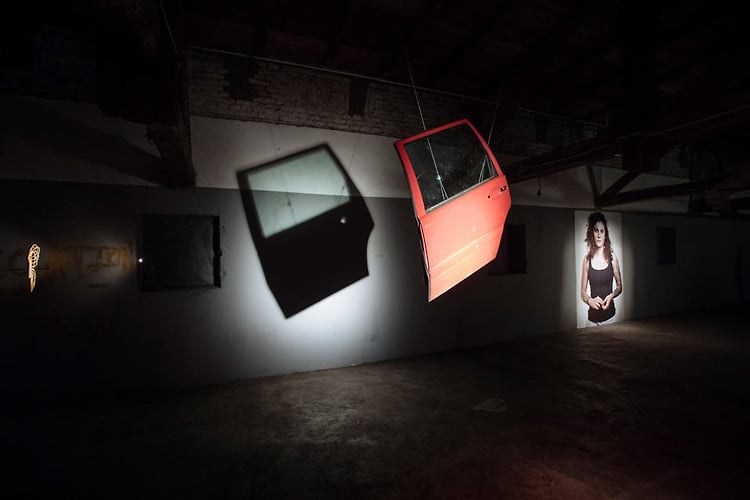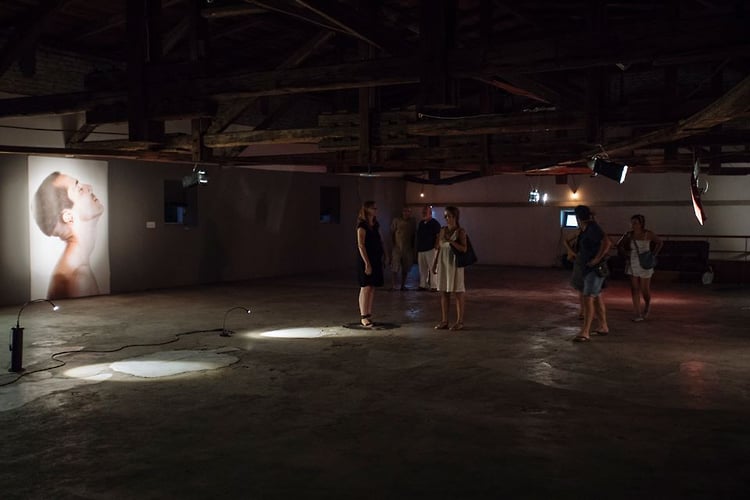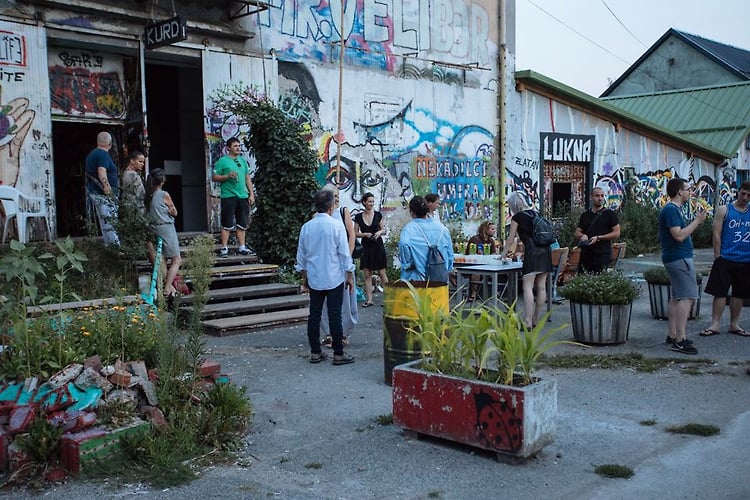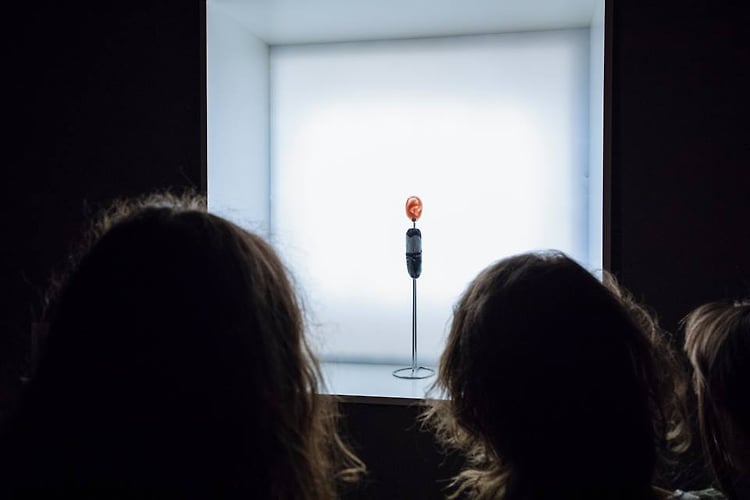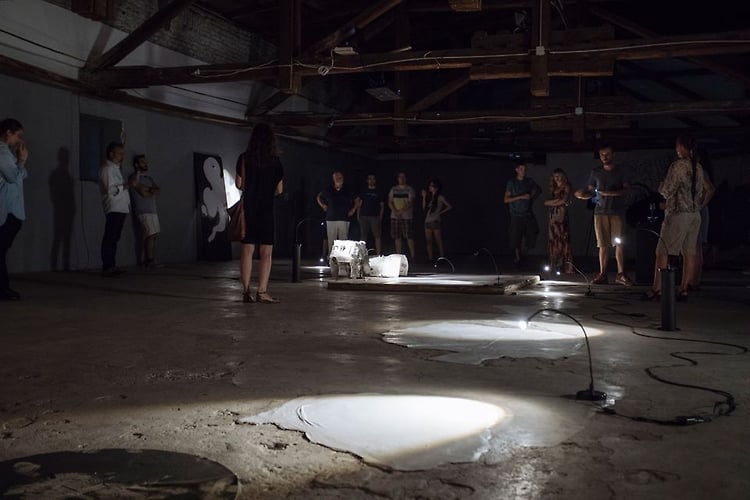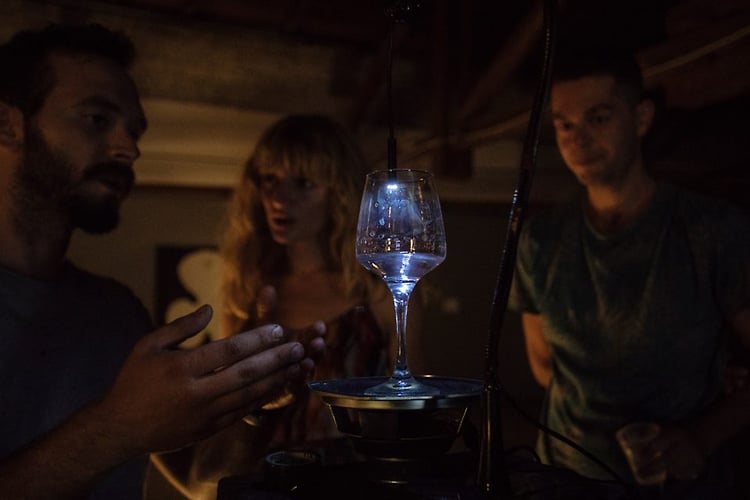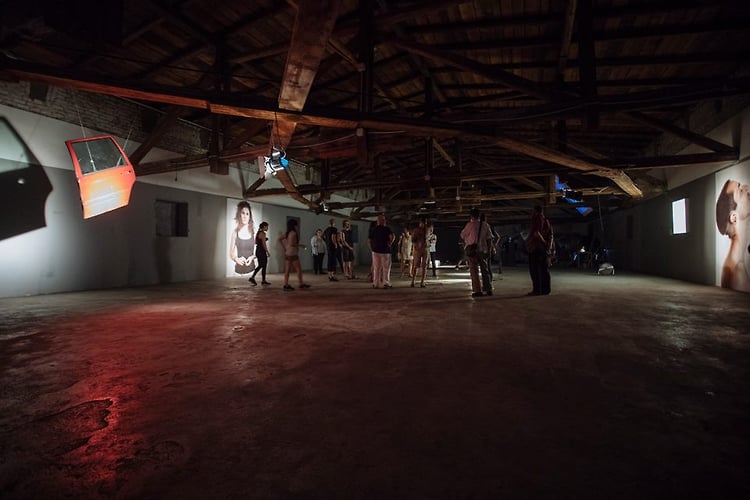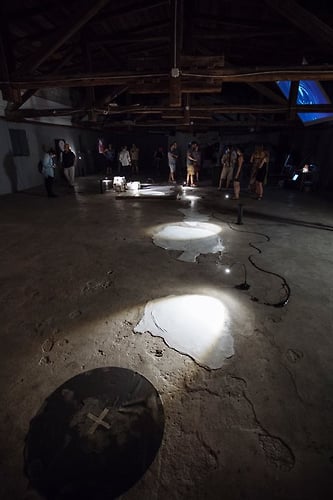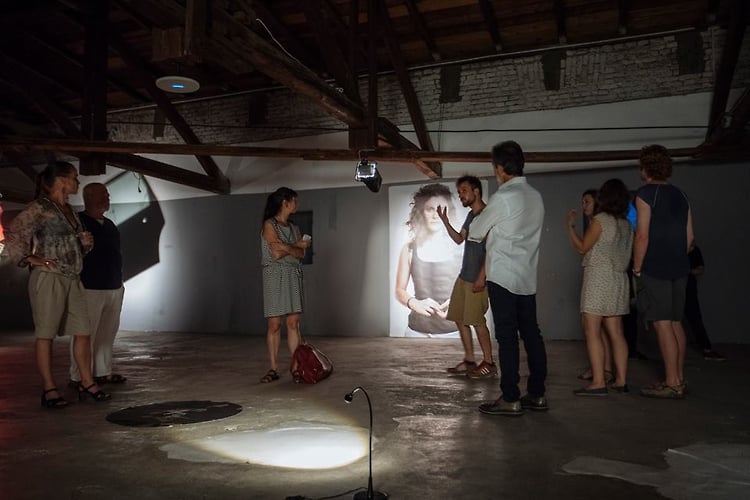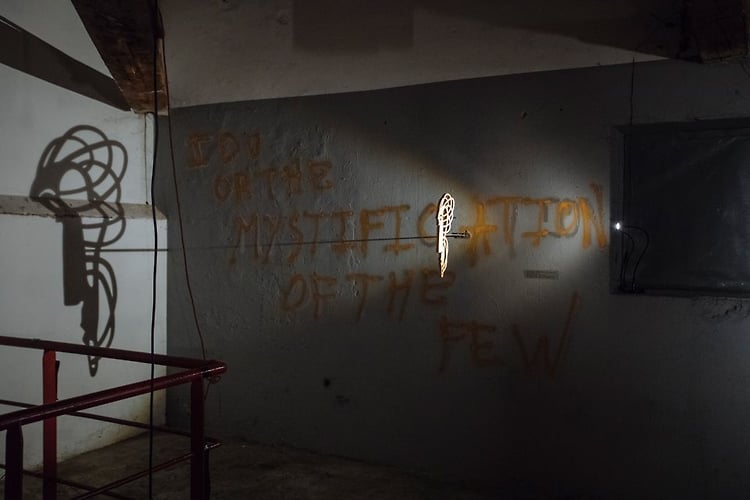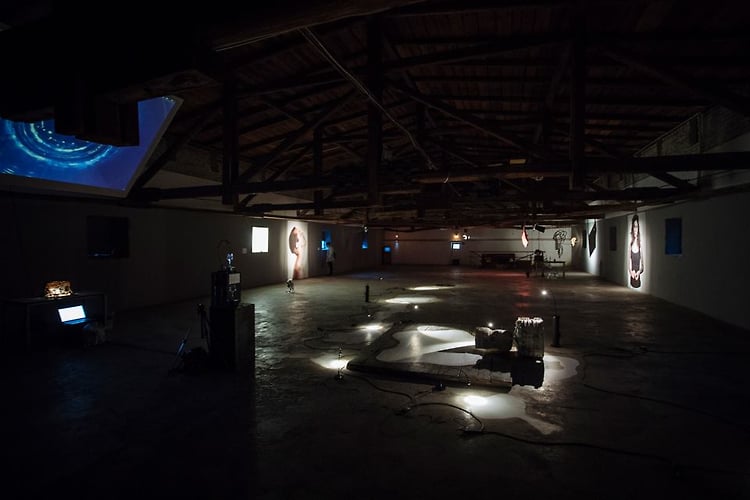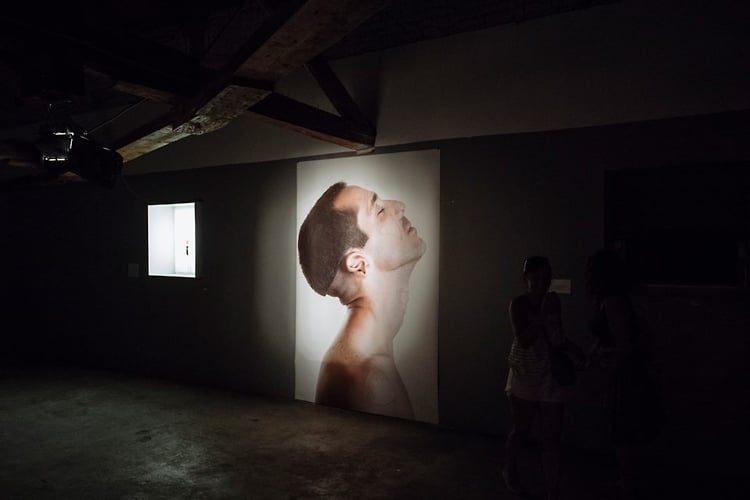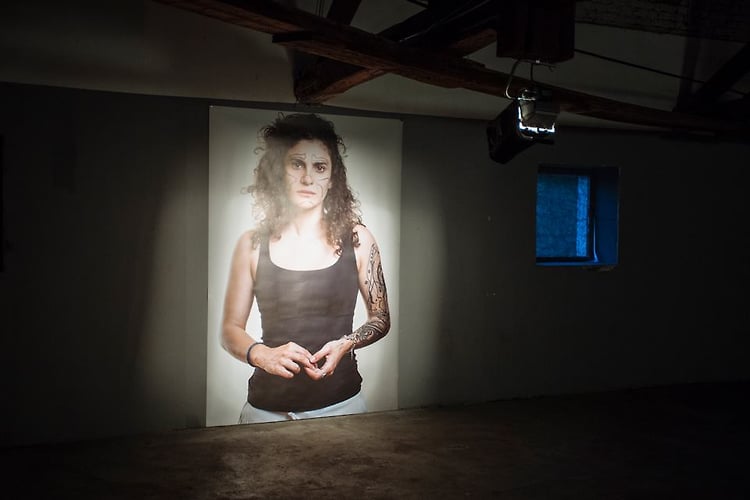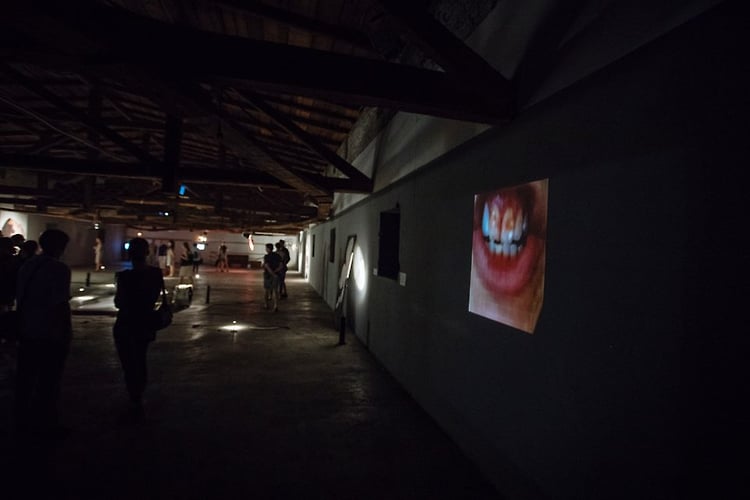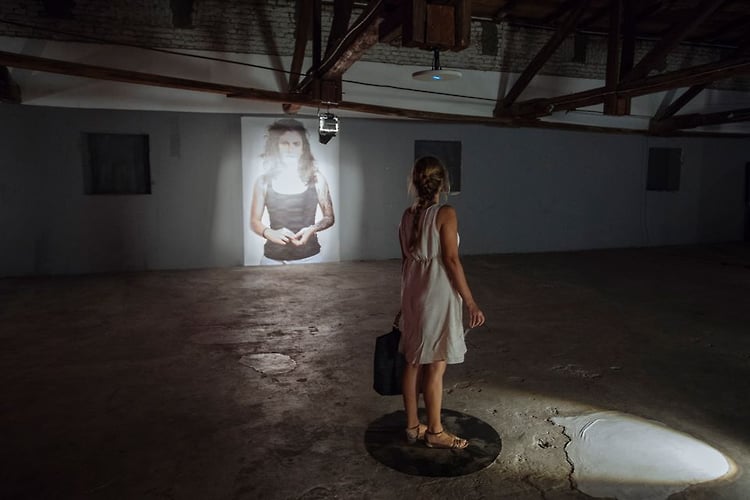LEBANON EXCHANGE 2017
Zuheir El Helou, Ghenwa Abou Fayad, Melissa Ghazale, Octave Khoury, Eli Mouhanna, Rita Tokatlian, Patil Tokatlian
Two Good Listeners Make a Piece with Silence
The act of listening requires presence. A silent presence. The silence which allows hearing well, whether or not the spoken words are to be understood. Perhaps this idea of listening can serve as a good metaphor for the mechanism behind an art residency such as Guest Room Maribor. In this particular case, six young artists based in Beirut came to Maribor as guests who tend to speak, but in order to do so, first, they had to listen. When shifting the familiar context of the megacity and coming to a small post-industrial town, the act of listening comes as the most important. And even though this residency was not about researching specific local phenomena, but rather about making an exhibition, it was important to establish a dialogue with newly found context as well as among each other. Artists Zouheir El Helou, Ghenwa Abou Fayad, Melissa Ghazale, Octave Khoury, Eli Mouhanna, Rita Tokatlian, Patil Tokatlian first time came together as a temporary group in which each member decided and determined conditions of their participation. Coming from the educational background of studying film at USEK University (Helou, Ghazale, Khoury, R.Tokatlian) and graphic design (Fayad, P. Tokatlian, Mouhanna) each of them had a position to speak from. The residency in Maribor came about as a continuation of their study program opening a space of art sphere and a gallery space. The dislocated position brings in something unnatural, as each of these artists suddenly doesn't recognize the language which surrounds them, lacks the common social or economic patterns and all that is left there has actually to do with art. And this is what makes an art residency so exquisite. How to make art and what does it mean? How to bring an idea about and shape it, how to present it within an exhibition?
Instead of a curator, here the significant role in the process had their mentor – former professor Miha Vipotnik – encouraging them to participate in Guest Room Maribor residency. Having the background in doing international collaborative projects which took place in Beirut, such as In Medias Res and Vertical Collisions, Vipotnik already had an idea of a direction this experiment could evolve to. The artists, still in search of their voice, came together with the exhibition entitled Two Good Listeners Make a Piece with Silence. The title in a humorous way addresses the situation in which none of the protagonists actually talks. The conversation is silent, but it doesn't mean it is not there. Same as John Cage composed his piece 4' 33'' for instruments which were not played. Instead of by instruments, the sound was made by three movements, which was perceived as silence. Despite silent composing, the piece was still there.
The exhibition unfolds with a work entitled National Understanding Committee, 2017 by Octave Khoury. The installation consists of several parts which may or may not be understood along the same line. The artist exposes work of a fictive character Vatek Rouchy, a translator and archiver who works for National Understanding Committee. His occupation of translator and archiver emphasizes an ambiguous role of not really participating but being present. It appears as if the story doesn't really concern him, even though he is a key person to shape it and share it further. The work has a lucid display, with a computer in the wall which leaves an impression of confidential content on its screen. The documents to be clicked on the screen are constructed as conversations and interviews which reflect current socio-political issues ravaging his country. The installation also consists of a video played in the corner which appears as documentary footage without clear content. It is up to the viewer to assume what this is even though it is explained as: "4 tapes from diverse personal collections". On the opposite side of the gallery, there is a red car door hanging from the ceiling. At the same time it functions as a ready-made in the art gallery but also it is a wreck, looking like a leftover of an accident. Next, to it, there is a graffiti saying: "Idu or mystification of the few" critically referring to the Lebanese religious traditions.
The idea of presence is in focus of a work Now you see me. Now?, 2017 by Ghenwa Abou Fayad who connects urbanism and memories of its experience. While she was in Beirut she made a self-portrait with a portrait of her colleague Elie Mouhana. The display in Hladilnica Gallery confronts the photos placed on the opposite sides. The perfection of nicely done photographs evokes the neatness of Benetton advertising campaigns leaving the viewer to wonder how does such commercial image shape one’s identity. That is why the interesting thing about these photos is not how well they are made but rather how are they shaped by visual interventions on their skin, appearing as tattoos, marks, or map lines, symbolizing the idea of mapping the experience of the city. Inscribed on their skin this is not merely aesthetics, it also comes as a scar that cannot be reversed. The two photographs are accompanied by earphones which bring diverse sounds from the city noise to birds singing and in this way, their experience is expressed through (dis)appearing sounds rather than urban elements. Moreover, by portraying Elie Mouhana, Ghenwa Abou Fayad brings his presence into the exhibition as he is the only participating artist who could not physically come to Maribor. Instead, his presence took many different shapes, as with Fayad’s work, and through numerous conversations about making this exhibition.
What makes his portrait specific is his opposite turned ear, as it was taken off and glued back without previous function. Right next to Fayad’s portrait of him, Elie Mouhanna exhibited an object entitled Wear it like an earpiece, 2017. The object (ear and an earring) is displayed in a small white cubicle which constructs the appearance of a luxurious artefact. But, as there is an ear it gives an allusion of a narrative in which the story of an earring has something to do with the wrongly turned ear on Fayad’s portrait. The title of the work is a proverb which asks the listener to measure the weight of uttered words as well as to wear them as a prosthesis. The soft material of this crocheted earring reminds of a pigeon who in the context of Beirut stands for a way of communicating when everything else fails. Pigeons were in fact often used for delivering letters during the civil war and ever since they are bred and trained in heights of skyscraper’s tops. This attempt to communicate through the distance is also reflected in the title of the exhibition which came from conversations between Miha Vipotnik and Elie Mouhanna who was (not) there.
Furthermore, present absence is in focus of Patil Tokatlian’s installation Dichotomy of Presence and Absence, 2017 in which she intervenes into gallery's space by shaping pieces of the floor as an integral part of her work. Newly created white shapes on the floor follow original holes in the floor of the gallery, reacting somewhat to the infrastructure of Pekarna space. As they resemble spilt milk they function as a bizarre invitation to the viewer to follow them, leading towards the sculptural installation on the floor and another installation on the wall. As the artist puts it: "The white hallucinogenic forms and installations feed on my emotions, senses, and beliefs. They spread around by creating an abstract and toxic environment; restoring the balance between my inner and outer worlds, calmness and chaos. Adapting with the other organisms in the space by synchronizing with the noises with my hypersensitivity."
Zouhair El Helou responds to an idea of making a sound by visually exposing its mechanism. In installation The Observable Manifestation of Hearing, 2017 he makes an interactive work inviting the viewer to press the button and shift the sound which consequently affects the shape of water in a glass. The video mapping the produced sound is on display above the whole installation. Underneath there are two plinths, one carries a press button inviting a viewer to participate, and the other a glass of water on a vibrating speaker. Behind them, the artist exposed a computer and back side of the mechanism which transfers sound. By making all these aspects visible, it appears as a mechanism of a certain conversation. And the fluidity of the water in that sense works well as the shape is constantly shifting.
Contrary to the work The Observable Manifestation of Hearing which exposes mechanism, Rita Tokatlian is more interested in a story to be told in her installation Rat Hole, 2017. Even though usually she is a filmmaker who deals with space solely on screen, this time she decided for the first time to intervene within the space and bring about more than just screen. She still holds to film, but this time it is barely visible as projected on transparent walls which surround a drawing of a humongous rat which stretches on the back wall. The whole work functions as an ambient which symbolizes a story to be told, a story to be misunderstood or to be interpreted. A rat hole, as the artist puts it, represents "an esoteric milieu, which allows the audience to be transported down a "rat hole". It is an ensemble of ideas, emotions and points of view of the world put together by the use of symbols, gestures, sound composition, light with moving images, and hypnosis with the aim of utilizing supernatural force to create a dreamlike magical, surrealistic mood for the spectator."
Starting with a National Committee for Understanding, the exhibition Two Good Listeners Make a Piece With Silence ends with a [Voice]. A work by Melissa Ghazale brings in the idea of an interrupted voice. She performs for a camera by opening her mouth as in an attempt to speak, but all she does is exposing teeth and bleeding gums. As if the attempt to speak failed ending up in glitch, as the image breaks. Visual noise of a broken image corresponds with interrupted and distorted sound coming from hanging earphones. Because of the noise, the message is interrupted and the listener can't hear well. The work is described by the dictionary definition of voice in which written sentences correspond to the nature of Ghazale's performance:
"1. the sound produced in a person's larynx and uttered through the mouth, as speech or song: Mel raised her voice.
a wave with a variable amplitude produced and propelled through various regions of the body.
vibration in the air picked up by ears and read intracranially.
[in sing.] The right to express an opinion.
a particular opinion or attitude expressed: a dissenting voice.
the ability to speak or sing: she'd lost her voice.
[usu. voices] the supposed utterance of supernatural voices: a strange voice was speaking through her.
the distinctive tone or style of a literary work or author: she had falsified her literary voice.
2. Grammar a form or set of forms of a verb showing the relation of the subject to the action: the voice of reason."
For the artist, the voice is conditioned by the body, and as such it inevitably depends on its social, even political context. Therefore, the artist brings about the issues of her political voice, attempt to speak, as well as the failure to do so.
Finally, this exhibition as a result of an artist residency surprises with how well it was achieved that artists with very diverse ideas and art practices find common ground. Albeit they don’t work together, as a collective would, within exhibition it is visible that there are connections between works and that there were conversations, perhaps even negotiations, about every aspect of this exhibition. And for that reason, in the exhibition were young artists confront the gallery space without the eye of a curator, it is even more important that the slippery terrain of a group show didn't make anyone fail, but rather by supporting each other's work they captured the viewer’s attention.
Irena Borić



